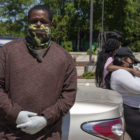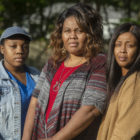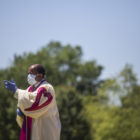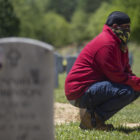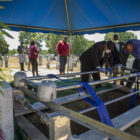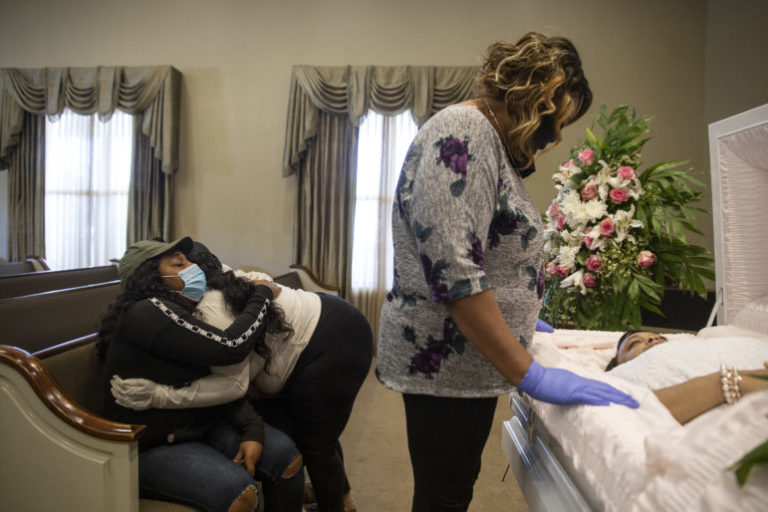
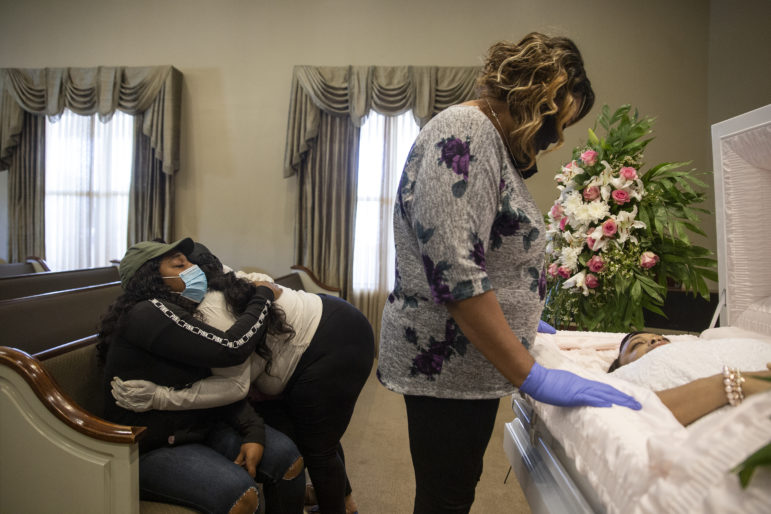
Eric J. Shelton/Mississippi Today, Report For America
Cassandra Rollins gazes down at her daughter, Shalondra Rollins, who died after complications of COVID-19, at the Jackson Memorial Funeral Home on April 15, 2020. Her youngest daughter, Tabitha, embraces her adopted sister Keda Woods. The family could not have a celebration of Shalondra’s life because of social distancing measures they must take to protect themselves against the virus that took Shalondra.
‘The Mystery of Death’
The story of Shalondra Rollins, the first person to die of COVID-19 in Hinds County, may tell us everything about why black Mississippians are hit so much harder by the pandemic
By Anna Wolfe | April 23, 2020
After her daughter fell suddenly ill, Cassandra Rollins raced towards the northwest Jackson apartment the morning of April 7th and found herself following the ambulance responding to the scene. It was traveling so slowly that Cassandra laid on her horn.
Three days earlier, her eldest child, 38-year-old Shalondra Rollins, received positive test results for COVID-19, a respiratory disease caused by the novel coronavirus. She had just started complaining that she “felt winded” that morning before collapsing in the shower.
“The ambulance was driving like it was a normal day, someone coming home from work,” Cassandra said. “It was no sense of urgency.”
Shalondra’s eyes widened when the EMTs told the family no one could accompany her to Baptist Medical Center as they loaded her into the vehicle. She said she would call them on her cellphone as soon as she arrived. They pulled away without turning on the siren or the red and white lights. Less than an hour later, Cassandra received a call from the hospital chaplain, who told her Shalondra’s heart had stopped while she waited for the hospital to find her a room.
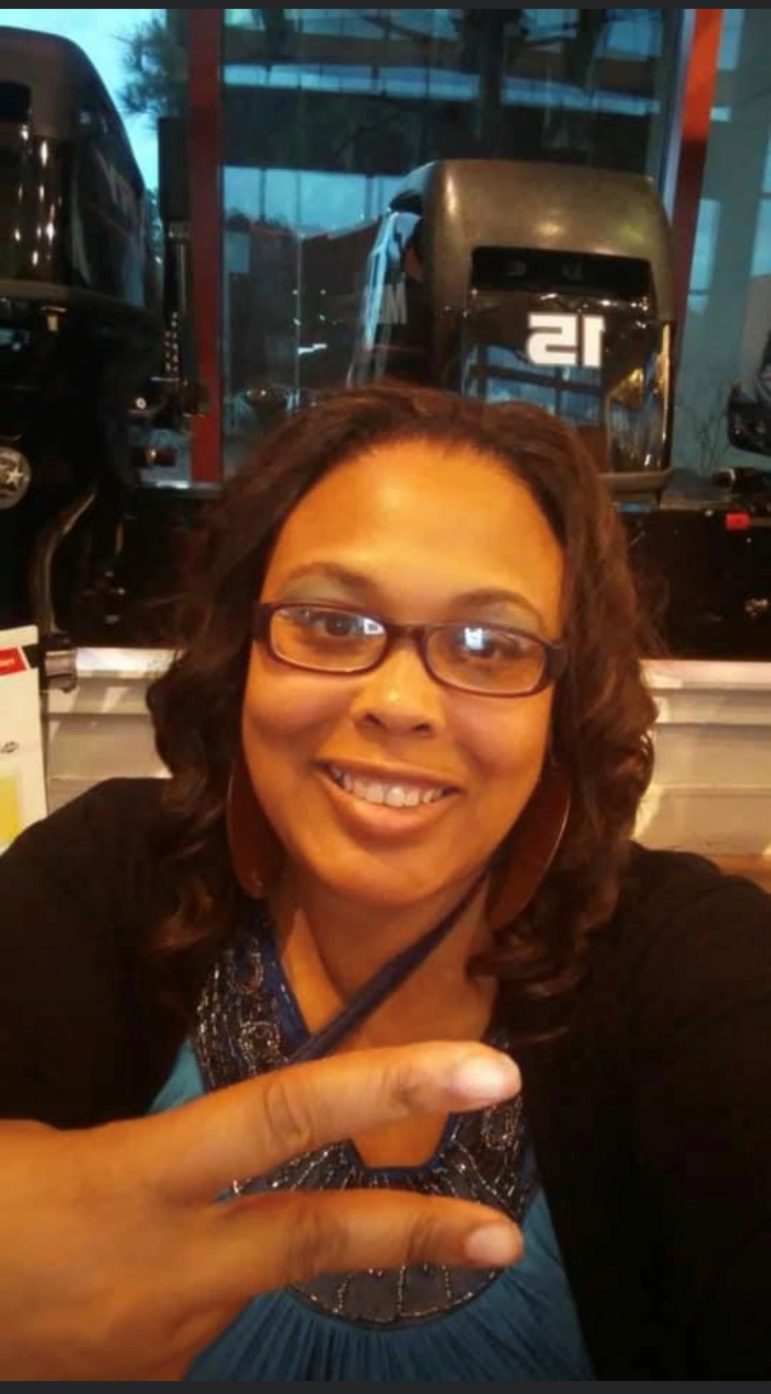
Shalondra was part of the working class; she had diabetes and lacked health insurance at times in her adulthood, factors that made her more susceptible to COVID-19.
But the family said she always managed her health well, rarely got sick and while she worked in low-wage jobs, she was moving towards a rewarding career in education — doing all the right things to improve her life.
And yet, she was the first person to die from COVID-19 in Hinds County, just as the state and nation was learning how the black community has been hardest hit by the disease. Despite African Americans representing less than 40 percent of Mississippi’s population, they represented 53 percent of COVID-19 cases and 63 percent of the related deaths through April 22.
Research shows that African Americans have less access to health care, but as the Rollins family say they’ve experienced, they also receive lower quality care when they do use the medical system, one of myriad factors leading to the community’s poorer health outcomes and younger deaths.
“This is the norm for us,” said Shalondra’s younger sister Sherrie Rollins, who spent several years struggling with the undiagnosed endometriosis despite constant doctor’s visits over the issue.
In Mississippi, black people are also nearly three times more likely to live in poverty and to be unemployed than white people. When people of both races live in poverty, African Americans are more likely to live in segregated areas with highly concentrated poverty, in neighborhoods where geography alone dictates that opportunities are scant.
As of April 22nd, 126 black people have died from COVID-19 in Mississippi.
African Americans are more likely to face COVID-19 exposure because they are over-represented in hourly jobs and essential positions that offer no option to work from home, plus they more often live in close proximity to others, in housing complexes and multi-family units.
These economic factors, plus the institutionalized and individual racism that perpetuates them, contribute to chronic stress that can wreak havoc on a person’s health.
“There are two hundred black people who die everyday in this country who wouldn’t die if there were no white-black differences in mortality,” David Williams, a professor of public health for Harvard’s T.H. Chan School of Public Health who also teaches African American studies and sociology at the university, said on a recent teleconference.
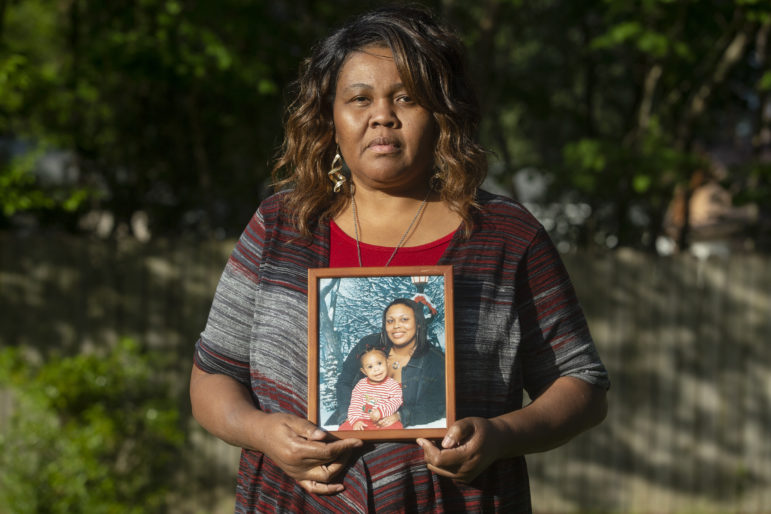
Eric J. Shelton/Mississippi Today, Report For America
Cassandra Rollins lost her daughter Shalondra, a special education assistant teacher and mother to two teenage daughters, due to complications from COVID-19 on April 7, 2020. Rollins believes the health care system did not treat her daughter as effectively as they could have.
Shalondra, an assistant public school teacher, first went to her primary care doctor, Dr. Timothy Quinn, in mid-March, after the pandemic had reached Mississippi, complaining of aches and chills. Dr. Quinn, who had just been tapped to sit on the city’s COVID-19 task force, diagnosed her with the flu and prescribed a Z-Pak of antibiotics, family members said.
Dr. Quinn said at that stage of the pandemic, providers struggled to acquire coronavirus tests and had limited testing to patients with specific symptoms. “It was not a lack of desire. It was a lack of accessibility,” Quinn told Mississippi Today.
Shalondra’s best friend, whom she had recently visited, also became ill and was tested for COVID-19. It took nearly two weeks for the friend to get her positive result back, at which point Shalondra got tested at an urgent care center.
The Mississippi State Health Department publishes the number of people it has tested and the much larger number tested at private labs — more than 54,000 by April 22 — but has not offered much demographic data to show who’s getting tested and where.
Shalondra’s family wonders how her outcomes may have been different if she had been tested for the virus earlier. Or if her friend had gotten her test results back sooner. Or if the urgent care clinic would have given her better instructions, possibly hospitalized her, after she eventually tested positive. Or if she had received more thorough care on the day she died.
That morning, Shalondra’s fiance, Kendrick Rogers, found her on the bathroom floor, gasping for air. Her youngest daughter, Makalin, who has asthma, put the mask from her own breathing machine over her mother’s face while they waited for what felt like an eternity, but was just under 12 minutes, for the ambulance to arrive.
“Can you imagine a 12-year-old in there trying to give her a breathing treatment and resuscitate her,” Cassandra said. “That’s where my anger is at.”
“When he told me it was the chaplain, I knew what it was.”
-Cassandra Rollins
When state officials began releasing the racial breakdown of COVID-19 cases and deaths showing the devastating impact on the black community, they attributed the trend to higher rates of underlying chronic illnesses among that population.
“This is not news. We’ve seen this before,” state epidemiologist Paul Byers said at a press conference on April 7th, just hours after Shalondra died.
The state’s COVID-19 data showed that black folks with heart disease represented the most deaths, followed closely by black people with diabetes and high blood pressure.
Shalondra, like her mother and 16 percent of black adults in Mississippi, had Type 2 diabetes, diagnosed just five years ago. But she was managing it well, her family said. She didn’t avoid the doctor and after a recent check up, Cassandra said, “she called me and told me, ‘Mama, my numbers were good.’”
“She wasn’t an unable body. We would play around the house, wrestle a little bit,” Rogers said, recollecting that she could hold him down so he couldn’t move. “She was very strong. She was very healthy.”
Diabetes makes people more susceptible to the virus and black folks in Mississippi are about 20 percent more likely to have the disease than white folks. Still, in Mississippi there are more diabetic white people than diabetic black people, and yet, among people with diabetes who have died from the virus, 80 percent were black.
The medical community’s approach to tackling racial heath disparities has been to find new ways to increase access to care, such as by allowing doctors to conduct visits with rural patients over video chat. But they acknowledge these are imperfect solutions to a problem sustained in part by economic barriers in the black community.
“Eating healthy is really expensive and eating unhealthy is really cheap,” said Dr. Javed Butler, University of Mississippi Medical Center professor and chairman of the department of medicine. “I don’t think we as a society have figured that out. You know, you can have a $1 burger, but you cannot have a $1 healthy meal.”
The emphasis on diet-related diseases brings into sharp focus the black community’s long-stereotyped relationship to food, in which socioeconomics, geography and stress play as big a role as what individual people decide to eat each day.
While Rogers said food was a source of comfort in the cash-strapped Rollins household, meal decisions were made consciously, limiting the plate to one starch, for example.
Federal legislation in response to COVID-19 increased benefits through the Supplemental Nutrition Assistance Program so that recipients in Mississippi got almost double the assistance in March that they received in February.
Calvin Head, a black farmer in the Tchula area, found recently while delivering fresh fruits and vegetables to homes in his community, one of the poorest in the nation, that despite the emergency assistance, people are still experiencing hunger.
“One lady said, ‘I’m going to be honest with you, I had to trade my stamps in to pay my rent,’” Head said. “I’m not saying it’s right but what do you do? Your income is limited.”
Head, who runs a farming co-op in the Mileston community of Holmes County, has facilitated programs over the years to involve high schoolers in growing crops and provide locally grown food to residents. It’s one way locals are trying to disrupt the area’s faulty food system, which includes the many acres of nutrient-rich soil owned by white farmers and used to grow corn and soy, food for livestock, not local residents.
“We’re trying to find ways to make the food safer,” said Tchula mom Lucannie Commings, who helps the co-op distribute produce to a town that is 99 percent black.
At the town’s only grocery store, a glorified gas station, Commings recently purchased a package of taco shells, which, she discovered when she arrived home, expired in 2018.
Publicly-funded interventions for black families with chronic diseases greatly emphasize behavior, such as programs that teach parents how to grocery shop and prepare healthy meals.
“Targeting the low-income communities and changing their behavior is going to be where we make inroads and help us combat obesity in our state,” said Arnell Wilson, the state director of SNAP-Ed, the educational program within SNAP, formerly known as food stamps.
But this focus, researchers find, ignores the structural reasons families can’t access the food that keeps them healthy — whether because they can’t afford it or because it doesn’t physically exist in their neighborhoods.
“Having to live in a racist society results in disparities in health including diabetes, obesity and hypertension,” said Kilolo Kijakazi, an Urban Institute fellow. “This is not just folks making poor choices. It is folks having to navigate a racist society that creates these sort of health challenges.”
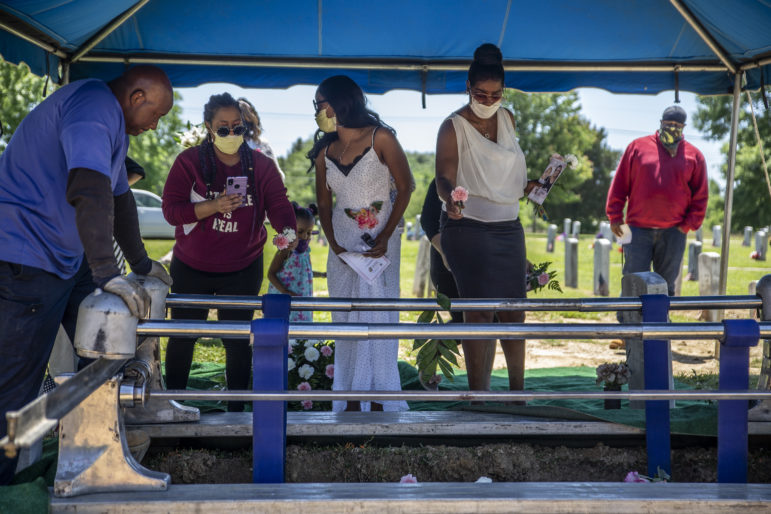
Eric J. Shelton/Mississippi Today, Report For America
Shalondra Rollins’s family members, cousin Erica Rollins, sister Sherrie Rollins and cousin Brenda Harris drop flowers into grave at Autumn Woods Memorial Gardens in Jackson on April 16, 2020 while Shalondra’s fiance Kendrick Rogers looks on.
Cassandra, the youngest of 11, gave birth to her first child Shalondra by cesarean section when she was 17. The baby girl was past due. “She didn’t want to come out,” Cassandra said, and even as an adult, “she was so attached to me.”
By the time she was 27, Cassandra was raising her two daughters, plus two nieces after her older sister’s murder. They lived in public housing in south Jackson, while the single mom worked at retailers and various state agencies.
“I come from a family where when I graduated, no one had graduated from college,” Cassandra said. “My mother was a poor woman, a maid. You didn’t have nobody to tell you about that.”
Shalondra, who helped take care of her younger siblings, similarly stayed in the workforce after graduating from Callaway High School in 2000. “She started working at 16 and she always kept a job,” Cassandra said.
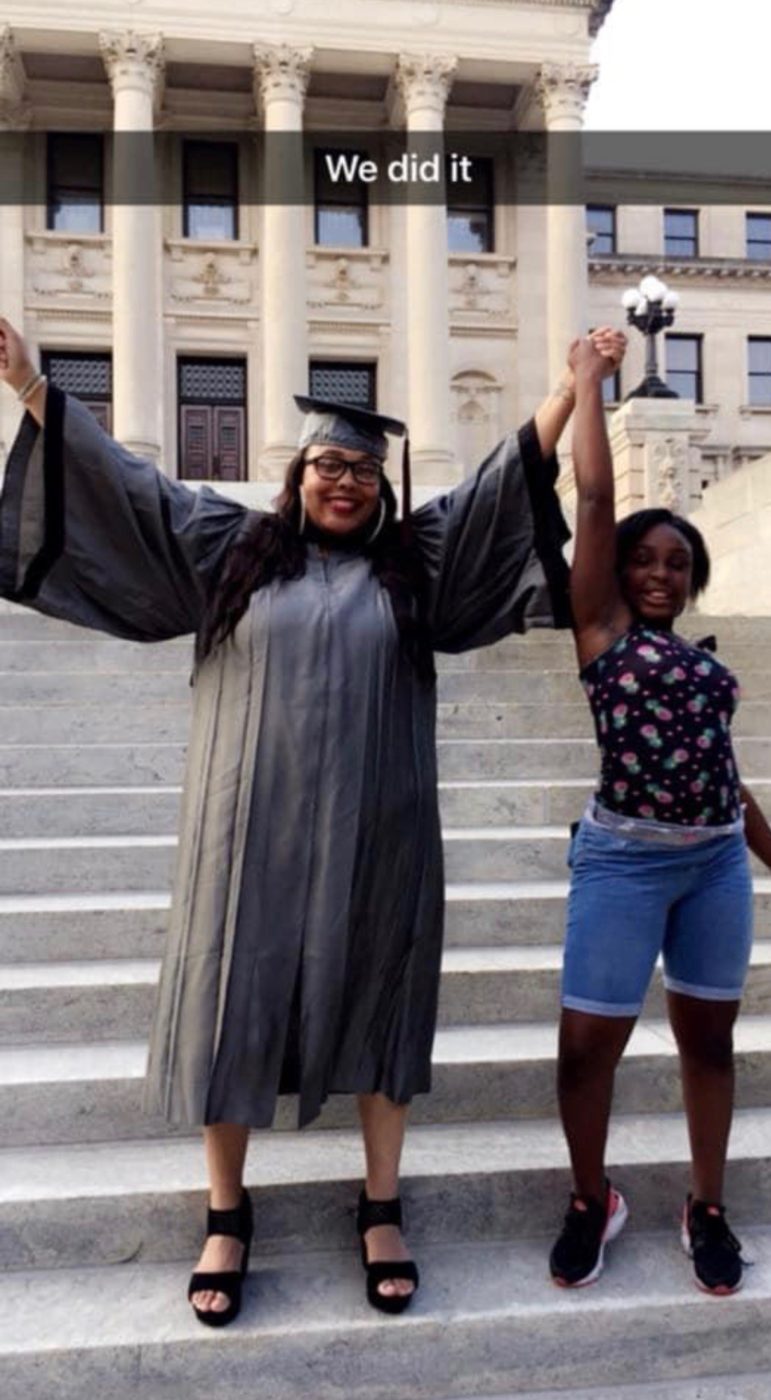
For nearly two decades Shalondra held low-wage fast food and retail cashier jobs until, after the birth of her two daughters in 2005 and 2007, she found her passion working at child care centers. She returned to Hinds Community College, earned her associates degree in early childhood education in 2018 and got a job as an assistant special education teacher at Spann Elementary School in Jackson.
“She was gifted at her craft,” said Avis Lloyd, the parent of one of Shalondra’s students with disabilities. “Her kids have consistently talked about her while they’ve been out of school.”
Shalondra’s career move and the additional education — for which she had to take on student loan debt — didn’t offer her the economic mobility often promised. In Mississippi, assistant teachers can make as little as $13,000 — after a $500 increase from the Legislature in 2019 — and earn about $20,000 a year on average, both below the poverty line for a single mother of two.
Shalondra was still reliant on a patchwork of public assistance but through the public schools job, she received state health insurance, benefits she often didn’t have previously.
“We were struggling but we always made the ends meet. She always made sure the house was taken care of,” said her fiancé Rogers, an army veteran who was diagnosed with post-traumatic stress disorder. “There were some periods where I couldn’t find stable work … She was always the one to say, ‘It’s going to be alright. We’re going to get through this. It’s going to be better days.’”
That seemed likely. Along with getting married and buying a house with her to-be husband, Shalondra planned to go back for her bachelor’s degree with Spann’s assistance so that she could become a fulltime teacher.
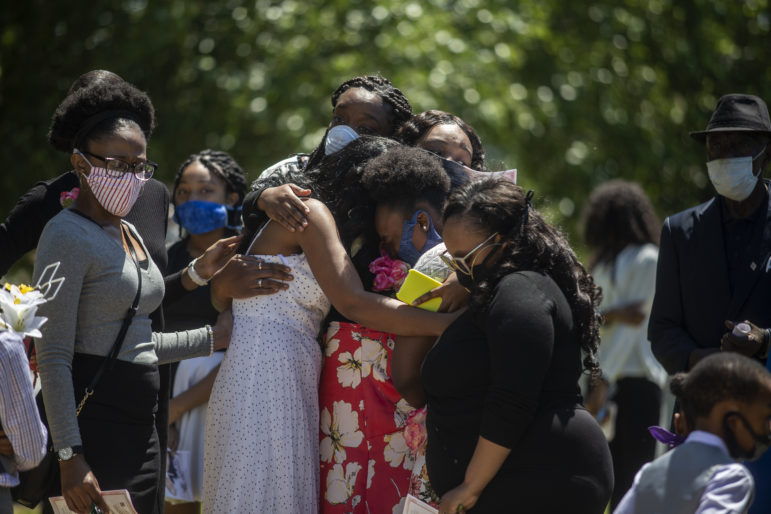
Eric J. Shelton/Mississippi Today, Report For America
Wearing protective masks at the graveside service for Shalondra Rollins on April 16, 2020, friends and family embrace. Their sister, cousin and friend died after complications with COVID-19 the week earlier.
In Mississippi, the average black household with children pulls $32,300 in annual income, less than half the income of the average white family. Black folks in the state are nearly three times more likely to be unemployed. Over 22 million Americans filed for unemployment in a month of COVID-19, more than 130,000 of which were in Mississippi. Even in better economic times, the number of people looking for work in Mississippi outnumbered the jobs available — a problem Congress could address through a federal jobs guarantee similar to the Work Progress Administration created during the Great Depression.
Income inequality is one reason for the even more startling racial wealth disparities nationally: For every dollar of wealth held by white families in America, black families have about 10 cents. Centuries of institutionalized discrimination, starting with slavery, Jim Crow, and more recent policies like redlining — in which banks strategically refused loans to black communities — has ensured these trends endure.
Without these reserves, black families are less able to withstand medical emergencies or economic recessions.
The federal Earned Income Tax Credit helps fill gaps for some low-incomes families, but 80 percent of the nation’s such tax subsidies, a crucial aid in the accumulation of wealth, benefit the top 20 percent of income earners. More than half of states have enacted their own credits for working families but Mississippi has not.
Black Mississippians are also 23 percent more likely than white Mississippians to lack health insurance, as they more often work for employers who do not offer the benefit. The working poor in Mississippi could receive coverage through expanding Medicaid, which would disproportionately help black residents, but state leaders have refused, leaving several billion federal dollars on the table over the last decade.
Advocates for the working class in Mississippi have had little success lobbying for wage increases or Medicaid expansion but continue to push intermediate solutions, such as helping low-income mothers break into higher paying careers.
Through coordinated child care and other work supports, the Biloxi-based Women In Construction workforce training program offers primarily black mothers a way to break into the better-paying advanced manufacturing jobs historically dominated by men. The students often say securing a job with health benefits is one of their main motivators for joining the class, said Program Director Ruth Mazara.
“It usually turns out that once you have that opportunity, you’re more likely to find a regular doctor and go to regular check ups and visits,” Mazara said, “rather than just trying to survive everyday and that being a lower priority.”
While higher education and greater wealth attainment has shown to improve a population’s health, racial health disparities do not disappear when you examine the outcomes of only the most educated and wealthy people in our society.
“There’s something else about race that matters profoundly,” Williams, the Harvard professor, said.
Evidence points to the damaging effects of lifelong racial discrimination on the body to explain disparities that exist in America even when you account for other social determinants of health, such as poverty and opportunity. Beyond bias in the medical system, African Americans experience stress at higher rates and greater clusters of stressors (“When they have one, they have another,” Williams said). Chronic stress is linked to higher blood pressure, weight gain, cognitive issues like memory loss and heightens the risk that pregnant women will birth their children too early.
Cassandra cited grief among her life’s greatest stressors. Her family has endured the separate murders of her two older sisters, the death of her mother to cancer, and her son, Tyler, died by suicide in 2019 while serving in the military.
After Shalondra’s death, Cassandra took in her two teenage daughters and she’s already preparing for hardships to come.
“I’m never going to be able to fill that void of their mother not being here,” she said.
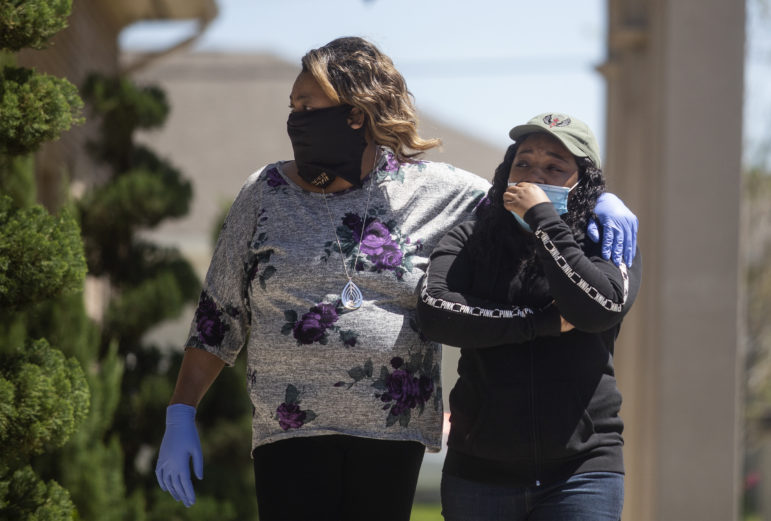
Eric J. Shelton/Mississippi Today, Report For America
Cassandra Rollins walks her youngest daughter, Tabitha Rollins, out of the Jackson Memorial Funeral Home on April 15, 2020. The family hosted a visitation for Shalondra Rollins, who died from COVID-19 the week earlier.
On the afternoon of Shalondra’s visitation, close family members wore face masks and gloves as they gathered, consciously distanced from each other, in the parking lot of the Jackson Memorial Funeral Home. It had been less than a year since they met to mourn the loss of Shalondra’s younger brother.
Cassandra clasped her blue rubber-covered hand around her eldest sister’s as she walked her inside the funeral home, where no more than ten at a time could enter.
On a screen behind the white casket, against a hazy pink background after a slideshow of family photos, an Oscar Wilde quote appeared: “The mystery of love is greater than the mystery of death.”
The funeral home had chosen the inscription. While it may be true for others, Cassandra said there’s nothing puzzling about the love she has for her children.
“I did everything humanly possible while they were here as a poor mother raising her children,” Cassandra said.
Her daughter’s death, on the other hand, still doesn’t make sense.
Clarification: An earlier version of this article should have said the State Health Department publishes the number of people it has tested and the much larger number tested at private labs.
The post Shalondra Rollins was taking care of her health and climbing out of poverty. Why did she die of COVID-19? appeared first on Mississippi Today.
- Wild hogs wreak economic havoc in Mississippi - December 24, 2025
- For Delta transplant, personal journey and Onward Store revival are aligned - December 24, 2025
- Hosemann urges fellow Republicans on election board to fight judicial redistricting order - December 23, 2025
